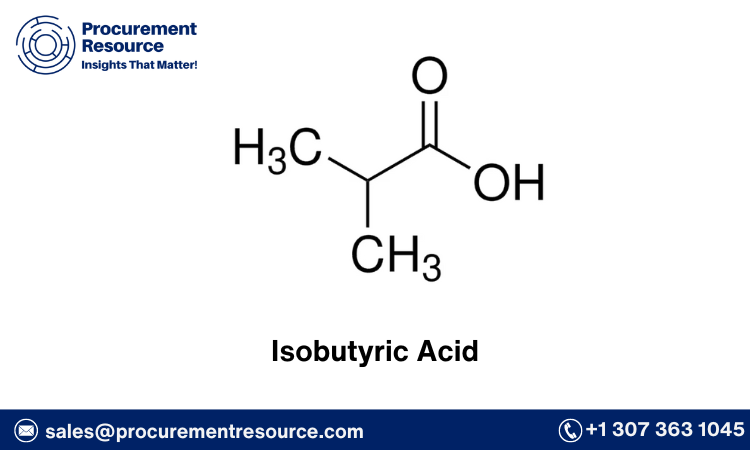
Isobutyric acid, also known as 2-methylpropanoic acid, is a colorless liquid with a pungent odor, widely used in the production of various chemicals, flavors, and fragrances. It is also an essential intermediate in pharmaceuticals and pesticides. Understanding the price trends of isobutyric acid is crucial for stakeholders in these industries, as it impacts cost structures and profitability. This blog delves into the recent price trends, market dynamics, and future forecasts for isobutyric acid.
Forecast Report
Short-term Forecast (Next 6 Months)
The short-term forecast for isobutyric acid prices suggests a moderate increase. Several factors contribute to this prediction. Firstly, the rising demand from the pharmaceutical and flavoring industries is expected to drive prices upward. The recovery of global supply chains post-pandemic has led to increased production activities, subsequently raising the demand for isobutyric acid.
Request For Sample: https://www.procurementresource.com/resource-center/isobutyric-acid-price-trends/pricerequest
Additionally, seasonal variations affect agricultural demand, which indirectly influences the prices. During the growing season, the need for pesticides (which use isobutyric acid as an intermediate) surges, causing a temporary spike in prices.
Long-term Forecast (Next 5 Years)
Looking at the long-term forecast, the price trend for isobutyric acid appears more stable but with a gradual upward trajectory. The increasing application of isobutyric acid in green chemistry and sustainable production processes is anticipated to bolster demand. Innovations in production technologies and the development of bio-based isobutyric acid will also play a role in shaping the market.
However, geopolitical factors, regulatory changes, and environmental concerns regarding chemical production could introduce volatility. The push for stricter environmental regulations might increase production costs, which could be passed down the supply chain, leading to higher prices.
Market Analysis
Supply and Demand Dynamics
The supply and demand dynamics are crucial in understanding the price trends of isobutyric acid. On the supply side, the availability of raw materials such as isobutyraldehyde and the efficiency of production processes are significant factors. Any disruption in the supply chain, such as plant shutdowns or raw material shortages, can lead to price fluctuations.
On the demand side, the primary consumers of isobutyric acid are the pharmaceutical, agrochemical, and fragrance industries. The growing global population and rising disposable incomes are driving the demand for these end-use products, thereby increasing the demand for isobutyric acid. Additionally, the trend towards natural and organic products is pushing the fragrance industry to use more isobutyric acid, further increasing demand.
Regional Market Insights
The market for isobutyric acid varies significantly across different regions.
North America
In North America, the demand is primarily driven by the pharmaceutical and agrochemical sectors. The region’s robust industrial base and advanced technological capabilities ensure a steady supply of isobutyric acid. However, stringent environmental regulations and high production costs could influence price trends.
Europe
Europe’s market is characterized by a strong demand from the fragrance and flavor industries. The region’s focus on sustainable and eco-friendly production methods is expected to drive the market for bio-based isobutyric acid. Regulatory pressures to reduce carbon footprints might also impact production costs and prices.
Asia-Pacific
The Asia-Pacific region is the fastest-growing market for isobutyric acid, driven by rapid industrialization and urbanization. Countries like China and India are major consumers, with significant demand from the pharmaceutical and agrochemical industries. The region’s relatively lower production costs and favorable government policies support market growth, but price volatility can be influenced by raw material availability and geopolitical factors.
Competitive Landscape
The competitive landscape of the isobutyric acid market includes several key players such as Eastman Chemical Company, BASF SE, and OXEA Corporation. These companies are focusing on expanding their production capacities and investing in research and development to innovate new applications and improve production efficiency.
Collaborations and partnerships are also common strategies to enhance market presence. For instance, strategic alliances between chemical manufacturers and end-use industries can lead to better supply chain management and price stabilization.
Latest News
Technological Advancements
Recent advancements in production technologies are set to revolutionize the isobutyric acid market. Innovations such as bio-based production methods and the use of renewable raw materials are gaining traction. Companies are investing in research to develop more efficient and sustainable production processes, which could potentially reduce costs and stabilize prices in the long term.
Regulatory Developments
Regulatory changes continue to shape the isobutyric acid market. In response to environmental concerns, several countries are tightening regulations on chemical production. This has led to increased compliance costs for manufacturers, impacting the overall pricing structure. However, these regulations are also driving the adoption of greener production technologies, which could benefit the market in the long run.
Market Expansions
Several key players are expanding their production capacities to meet the growing demand. For example, Eastman Chemical Company recently announced the expansion of its isobutyric acid production facility in Texas. Such expansions are aimed at ensuring a stable supply and catering to the increasing demand from various end-use industries.
Mergers and Acquisitions
The isobutyric acid market has seen a wave of mergers and acquisitions as companies seek to strengthen their market positions. These strategic moves are aimed at consolidating market share, enhancing production capabilities, and expanding product portfolios. For instance, the acquisition of smaller firms with specialized technologies can provide larger companies with a competitive edge.
Conclusion
The price trend of isobutyric acid is influenced by a complex interplay of supply and demand dynamics, regional market characteristics, and regulatory developments. While short-term fluctuations are expected due to seasonal and market-specific factors, the long-term outlook remains positive with steady demand growth. Technological advancements and strategic expansions are likely to stabilize prices and ensure a sustainable supply. Staying informed about these trends is crucial for stakeholders to navigate the market effectively and make informed business decisions.